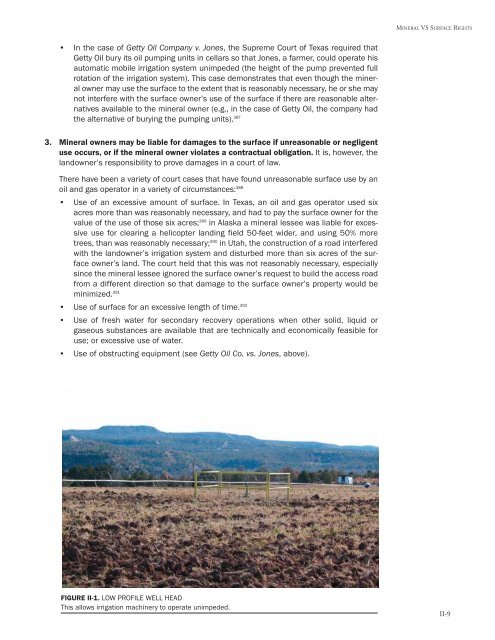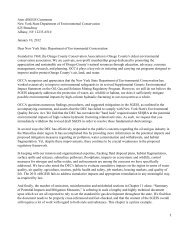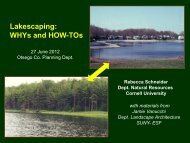Oil and Gas at Your Door? (2005 Edition) - Earthworks
Oil and Gas at Your Door? (2005 Edition) - Earthworks
Oil and Gas at Your Door? (2005 Edition) - Earthworks
You also want an ePaper? Increase the reach of your titles
YUMPU automatically turns print PDFs into web optimized ePapers that Google loves.
MINERAL VS SURFACE RIGHTS<br />
• In the case of Getty <strong>Oil</strong> Company v. Jones, the Supreme Court of Texas required th<strong>at</strong><br />
Getty <strong>Oil</strong> bury its oil pumping units in cellars so th<strong>at</strong> Jones, a farmer, could oper<strong>at</strong>e his<br />
autom<strong>at</strong>ic mobile irrig<strong>at</strong>ion system unimpeded (the height of the pump prevented full<br />
rot<strong>at</strong>ion of the irrig<strong>at</strong>ion system). This case demonstr<strong>at</strong>es th<strong>at</strong> even though the mineral<br />
owner may use the surface to the extent th<strong>at</strong> is reasonably necessary, he or she may<br />
not interfere with the surface owner’s use of the surface if there are reasonable altern<strong>at</strong>ives<br />
available to the mineral owner (e.g., in the case of Getty <strong>Oil</strong>, the company had<br />
the altern<strong>at</strong>ive of burying the pumping units). 387<br />
3. Mineral owners may be liable for damages to the surface if unreasonable or negligent<br />
use occurs, or if the mineral owner viol<strong>at</strong>es a contractual oblig<strong>at</strong>ion. It is, however, the<br />
l<strong>and</strong>owner’s responsibility to prove damages in a court of law.<br />
There have been a variety of court cases th<strong>at</strong> have found unreasonable surface use by an<br />
oil <strong>and</strong> gas oper<strong>at</strong>or in a variety of circumstances: 388<br />
• Use of an excessive amount of surface. In Texas, an oil <strong>and</strong> gas oper<strong>at</strong>or used six<br />
acres more than was reasonably necessary, <strong>and</strong> had to pay the surface owner for the<br />
value of the use of those six acres; 389 in Alaska a mineral lessee was liable for excessive<br />
use for clearing a helicopter l<strong>and</strong>ing field 50-feet wider, <strong>and</strong> using 50% more<br />
trees, than was reasonably necessary; 390 in Utah, the construction of a road interfered<br />
with the l<strong>and</strong>owner’s irrig<strong>at</strong>ion system <strong>and</strong> disturbed more than six acres of the surface<br />
owner’s l<strong>and</strong>. The court held th<strong>at</strong> this was not reasonably necessary, especially<br />
since the mineral lessee ignored the surface owner’s request to build the access road<br />
from a different direction so th<strong>at</strong> damage to the surface owner’s property would be<br />
minimized. 391<br />
• Use of surface for an excessive length of time. 392<br />
• Use of fresh w<strong>at</strong>er for secondary recovery oper<strong>at</strong>ions when other solid, liquid or<br />
gaseous substances are available th<strong>at</strong> are technically <strong>and</strong> economically feasible for<br />
use; or excessive use of w<strong>at</strong>er.<br />
• Use of obstructing equipment (see Getty <strong>Oil</strong> Co. vs. Jones, above).<br />
FIGURE II-1. LOW PROFILE WELL HEAD<br />
This allows irrig<strong>at</strong>ion machinery to oper<strong>at</strong>e unimpeded.<br />
II-9




